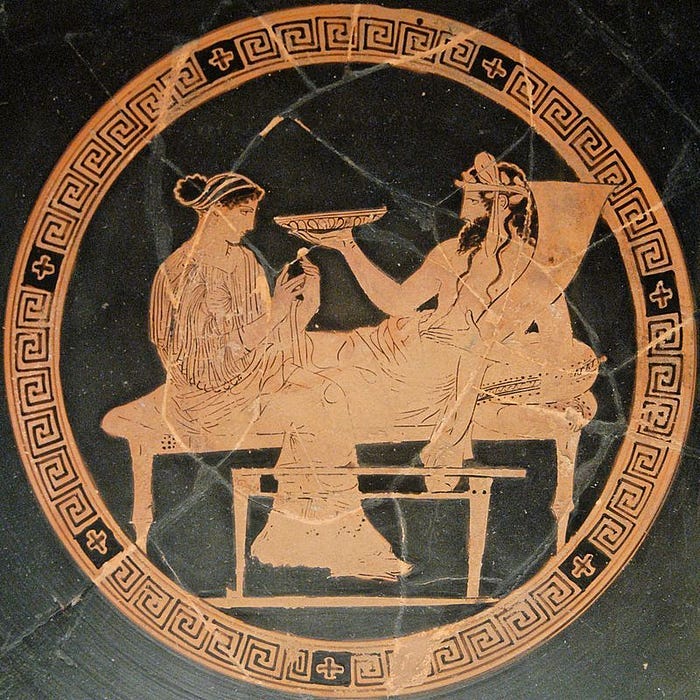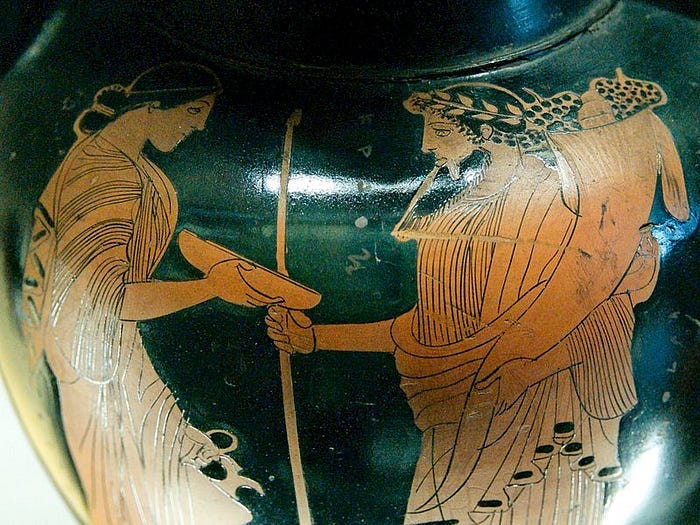Why The Greek Deity Of The Underworld Was Also The God Of Wealth
An interesting way to look at life, riches, and death

The ancient Greeks had a fascinating way of cramming complex concepts into a simple word or idea.
Perhaps historian Edith Hamilton puts it best. In her book The Greek Way, she notes the Greeks loved “beauty with economy,” and extended this to most things in their culture.
In other words, their buildings, poetry, military formations, and even their gods developed an elegance in their lack of extravagance. For instance, while a deity is usually otherworldly, those of the Greeks were…well, common. They looked like normal people.
Although their simple form could take on an enormous meaning large enough to fill a psychology textbook. I kept this in mind recently as something came to my attention. It turns out the Greek deity of the underworld was also the god of wealth.
At first thought, it’s an odd combo. Why would the lord of the dark realm of the dead be associated with plenty? There’s almost a mental barrier between being alive with plenty and being dead and requiring nothing.
Although, in their typical way, the ancient Greeks stuffed ten pounds of thought and concept within a five-pound bag of their god named Hades.
But it only truly becomes clearer as you examine their lives and culture a little deeper.
Death And Another View Of The Earth
Wu Mingren at Ancient Origins reveals the Greeks considered death a “taboo” subject — like we do today. Although Hades was considered a major deity, the lord of the underworld appeared less in art than the other Olympic gods.
In fact, there were also no firm rules on how to represent him in images. However, it wasn’t unusual for him to be pictured with a cornucopia, or horn of plenty. This was due to Hades’ home.
While the top Greek gods lived on the stately manor of Mount Olympus, Hades was by himself under the earth. Obviously, this doesn’t sound appealing. But in Hellenistic times this was a prime location: it was where all riches came from for the world of the living.
Metals such as silver and gold were found under the soil. And speaking of soil, this precious dirt created a bounty of food that enabled the community to eat and prosper. Now, suddenly it all makes more sense.
A mixture of dirt, earth, and wealth seems more palatable, but there’s still a bit lost in translation without a history lesson.
Olives, Silver, And Wealth
Mark Cartwright at the World History Encyclopedia says olives were first grown by humans about 5,000 BC on the coast of present-day Israel. They reached Greece by trade a few thousand years later. By the late Bronze Age, the Greeks were cultivating their own olives.

They were an ideal crop for the Mediterranean, which only needed seasonal warmth and a little bit of water. So, it wasn’t hard to grow more than you needed. This led to olives and olive oil being one of the great export goods in the ancient world. They also became a symbol.
An olive wreath crown was an award for a victory in the Olympics.
Olive branches accompanied visitors to the Oracle at Delphi.
Athenians believed their patron goddess Athena gave mankind the olive tree.
Olive trees were planted in Greek colonies all over the Mediterranean.
Furthermore, olive oil was used for more than just food. Cartwright says the Greeks used it to clean their bodies, as fuel for lamps, and in medicines, and perfumes. It was also a war objective
Historian Victor Davis Hanson in A War Like No Other explains the Spartans attacked the Athenians’ olive trees while the latter hid behind their walls in the Peloponnesian War. Although the trees proved hard to kill. Hanson says they’re difficult to burn and grow back when hacked apart. But olive trees were only one form of the earth’s wealth.
In 483 BC, Athens found a massive silver vein in their territory, which equated to a hundred talents. The politician Themistocles talked the citizens into using it to build a navy. This fleet eventually led a force that defeated the Persians. It also gave Athens an empire of its own.
By the start of the Peloponnesian War in 431BC, Hanson says Athens had six thousand talents in its treasury, which equates to about three billion dollars in modern money. Much of it grew from a mixture of trade with olives and silver dug out of the ground. Talk about wealth from the earth.
Although Hades and his earthly home had a darker side.
Winter And Death
While the Spartan’s torches and blades couldn’t kill the olive trees, one thing could blunt them: Winter. And Hades has a connection here. In the greatest Greek myth connected to him, he abducts Demeter’s daughter Persephone and takes her to the underworld.
As Mingren notes, since Demeter was the goddess of the harvest and farming, she refused to let crops ripen until her daughter was returned. To calm the chaos, the king of the gods, Zeus, stepped in. Zeus negotiated that Persephone would spend most of the year with her mother but would return under the earth with Hades for a third of it.
So, this myth explains the seasons — the birth and death of all things green in nature. Likewise, humans have seasons. While we get our time above the earth, eventually winter comes and Hades calls. Moreover, even the precious metal gets returned to the ground.
In Greek folklore one must cross the river Styx to get to the realm of the dead by way of a ferry. The rower, named Charon, expected payment. So, the family of the dead put a coin in the mouth of the corpse to help them on their journey.
According to Mingren, the Greeks may have considered death taboo, but didn’t hate Hades. He was seen as firm but fair. Plus, the god wasn’t one that could be outwitted; he had a tight grip on his underworld kingdom.
With all this in mind about Hades, death, wealth, and life, let’s move to the present day.
Rethinking The Ancient Concept Of Hades For The Modern Day

Each human life is precious and unique. In many ways, it’s not something you could ever put a dollar value on, yet the human body is much different. In fact, it can be quantified.
In his documentary The Secret Life of Chaos, theoretical physicist Jim Al-Khalili reveals ninety-nine percent of the human body is a mixture of air, water, coal, and chalk, with the combination costing only dollars to make. Alexander the Great got this lesson long ago in the strangest of places.
While he moved through India he met a gymno-sophist (naked philosopher) named Calanus. This mystic wasn’t impressed with Alexander. Moreover, he and his cult stomped on the dirt as they viewed the conqueror.
Calanus explained that no matter how much land you occupy, you’ll eventually be confined to enough earth for your two feet, so you can be buried.
As the Greeks tended to do, they impressed that deep idea into the simple vision of Hades. While the earth provides the very goods which can make us rich and happy, it eventually calls us back to that very dirt. We’re a clever combination of air, water, coal, and chalk.
It’s a humbling thought to balance the ego, and a sobering way to look at the things which bring you wealth, done with the traditional Greek flare for economy.
-Originally posted on Medium 7/9/23


